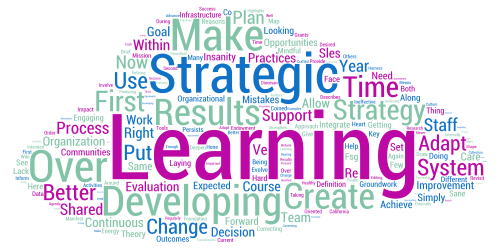
Like you, we care about getting better at what we do. Along the course of EHF’s first year, we’ll make mistakes. We’ll need to adapt. Right now, EHF is laying the groundwork for continuous improvement processes.
If the definition of insanity is doing the same thing over and over again and expecting different results, then strategic learning is simply sane. Strategic learning is being mindful of the outcomes that are achieved and why, and then course correcting to achieve better results. While the insanity approach to creating results is ineffective, there are many reasons why it persists. Let’s face it, we’ve all been there. Not only is change hard, but organizations often lack systems that allow strategies and practices to adapt over time in support of the mission.
At EHF we’re putting energy into supporting organizational learning, both internally and externally. The team at EHF is developing a Strategic Learning and Evaluation System (or SLES, first coined by FSG) that will provide opportunities to evolve organizational strategy and to deepen the Foundation’s impact over time. The California Endowment describes their SLES as “a forward-looking, integrated, learning–oriented, and adaptable set of processes that will help strengthen decision-making.”
Here are just a few highlights of EHF’s current work developing this system.
Strategy Development
At the heart of what we do is our Theory of Change, or map of how our desired change (transformation to healthy communities) is expected to manifest. We are refining our Theory of Change and engaging others in its development. The key to success will be to revisit it and our strategies during regularly-planned opportunities to see if they are producing the intended results.
Evaluation Activities
EHF is creating a process by which to harness the learning from evaluation and integrate it into decision-making around grants, research, convening, and Diocesan engagement. This would involve formalized data collection systems to inform learning and how it is taking shape in partnership with communities.
Infrastructure & Culture
The commitment to learning at EHF also means that we have dedicated time for learning and a shared responsibility for continuous improvement. I’ll give three brief examples of the mechanisms that we are using to hone our learning practices:
The first is the use of a learning agenda. Simply put, we are making decisions about what is most important to learn now, in order to advance the work. There is never enough time to learn everything.
Second, EHF is creating an infrastructure for knowledge sharing so that staff have the right tools to co-create and draw on lessons learned. We are experimenting with the use of a wiki, or a website that allows collaborative editing, to support more systematic sharing on team projects.
Finally, EHF has invested in staff professional development. Each staff has crafted a stretch goal for the year that furthers EHF’s goals and strategies, as well as personal development.
We are interested in hearing from you your own continuous improvement practices, what makes them thrive within your organization, and where you have identified opportunities that lead to better results. We are looking forward to learning with you.